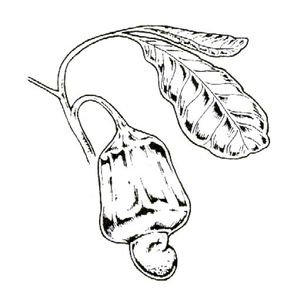
The cashew tree is evergreen. It grows up to 12 metres high and has a spread of 25 metres. Its extensive root system allows it to tolerate a wide range of moisture levels and soil types, although, commercial production is advisable only in well-drained, sandy loam or red soils. Annual rainfall needs to be at least 889mm (35 inches) and not more than 3048mm (120 inches). Cashew trees are most frequently found in coastal areas.
The main commercial product of the cashew tree is the nut. In the main producing areas of East Africa and India, 95% or more of the apple crop is not eaten, as the taste is not popular. However, in some parts of South America and West Africa, local inhabitants regard the apple, rather than the nut kernel, as a delicacy. In Brazil, the apple is used to manufacture jams, and soft and alcoholic drinks. In Goa, in India, it is used to distil a cashew liquor called "feni".
The cashew fruit (figures 1 and 2) is unusual in comparison with other tree nuts since the nut is outside the fruit. The cashew apple is an edible false fruit, attached to the externally born nut by a stem. In its raw state, the shell of the nut is leathery, not brittle. It contains the thick vesicant oil, CNSL, within a sponge-like interior. A thin testa skin surrounds the kernel and keeps it separated from the inside of the shell. The primary products of cashew nuts are the kernels which have value as confectionery nuts. Cashew nut shell liquid (CNSL) is an important industrial raw material for resin manufacture and the shells can be burned to provide heat for the decorticating operation.
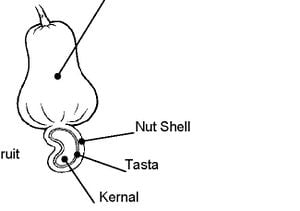
Processing overview[edit | edit source]
Traditionally, extraction of the kernel from the shell of the cashew nut has been a manual operation. The nut is roasted which makes the shell brittle and loosens the kernel from the inside of the shell. By soaking the nuts in water, the moisture content of the kernel is raised, reducing the risk of it being scorched during roasting and making it more flexible so it is less likely to crack. The CNSL is released when the nuts are roasted. Its value makes collection in sufficient quantities economically advantageous. However, for very small-scale processors, this stage is unlikely to take place due to the high cost of the special roasting equipment required for the CNSL collection (see the section on 'hot oil' roasting). If the nuts are being manually shelled, gloves need to be used or alternatively, the nuts should be tumbled in sawdust or ashes to absorb the liquid coating which has a harmful affect on the skin.
The shell can be cracked either manually, using a hammer, or mechanically. Manually operated blade openers (as listed in the supplier's section) are relatively inexpensive, however the more successful mechanical methods depend on the nuts having passed through the 'hot oil' CNSL extraction operation. Care must be taken not to break or split the kernel at this or subsequent stages as whole kernels are more valuable than broken ones. Once the kernel is removed from the shell, it is dried, the testa is peeled off and the kernel is graded. Figure 3 gives an overview of cashew nut processing and the various choices in methods.
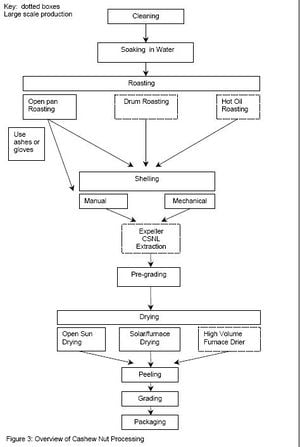
Cleaning
All raw nuts carry foreign matter, consisting of sand, stones, dried apple etc. The presence of foreign matter in the roasting operation can be avoided by cleaning the nuts. The raw nuts can be sieved by hand using a ¾ inch mesh sieve.
Soaking
The next stage is to soak the nuts in water to avoid scorching them during the roasting operation. This can be done by placing the nuts in a 40-45 gallon drum or vat and filling it with water until all the nuts are covered. After being left to stand for about ten minutes, the water should be drained off via a plug near the base of the drum. The nuts should then be left for periods of not less than four hours in order to allow the water left on the surface of the nuts to be absorbed. The process of covering the nuts with water, draining and standing should be repeated with the same nuts about three times until a moisture content of 9% is reached.
Where the production output runs from 2-10 tons of nuts per day, a simple cleaning and conditioning arrangement can be used. Two people open the sacks of harvested nuts on a stand and clean the raw nuts as they are moved along a flat sieve, to two vats which are used for storage until the soaking process begins. Two vats are useful because one can be emptied while the other is being filled.
Roasting
The application of heat to the nut releases the nut shell liquid and makes the shell brittle which facilitates the extraction of the kernel when breaking the shell open. Three methods of roasting exist: open pan, drum roasting and the 'hot oil' method. The latter is more suitable to medium-scale operations with associated higher equipment costs and viability of CNSL collection.
- Open pan: An open, mild steel, circular dished pan of around 2 feet in diameter is supported on a basic earth fireplace. When heated, 2-3lbs (1kg) of nuts are placed on the pan at one time and stirred constantly. The CNSL starts to exude and then ignites. This produces a long flame and black smoke. After approximately two minutes, the pan is dowsed and the charred, swollen and brittle nuts are thrown out of the pan. The moisture evaporates quickly leaving the nuts ready for shelling.
- Drum roasting: The idea of continually feeding the nuts into a rotating drum over a fire developed from the pan method. A slight horizontal slope in the mounting ensures the movement of the nuts through the drum. The drum is pierced so that the flames touch the nuts and the smoke is controlled by a hood and chimney arrangement. The nuts are dowsed using a continuous spray.
This process was further modified by using the heat from the burning CNSL being harnessed to roast the nuts some more. The roaster consists of a contained helical screw which moves the burning nuts at a controlled rate. The design was a distinct improvement, with little fuel being consumed and there being greater control on the roasting time.
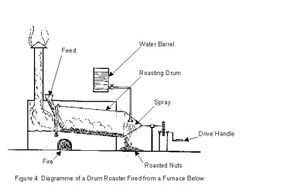
- 'Hot oil' method: The principle employed in this method is that oil-bearing substances i.e. the shells, when immersed in the same oil at high temperature, will lose their oil, thus increasing the volume of the oil in the tank. For this method, conditioning becomes important. The equipment consists of a tank of CNSL heated to a temperature of 185-190°C by a furnace underneath and a wire basket used to hold the nuts for immersion into the tank. The depth of the basket must be sufficient so that the rim remains well above the oil during the roasting. Immersion time can range from 1½ to 4 minutes. About 50% of the liquid is extracted from the nuts. Draining trays are needed at the end of the tank for the roasted nuts to dry and the residue oil can be returned to the tank. Caution must be taken not to heat the tank to over 200°C because at this point polymerization of the CNSL takes place. The temperature can be maintained by continuous firing. The tank should be emptied and cleaned after each day's roasting. The life of a tank made of an eighth inch thick mild steel plate should exceed one and a half years and can be constructed locally with welding facilities.
Shelling
The objective of shelling is to produce clean, whole kernels free of cracks. In India, this operation has always been done manually. Other countries have difficulty in competing with the great skill and the low wages of the Indian workers. Therefore, India has enjoyed a virtual monopoly of cashew processing for a long time. Manual shelling is still relevant to the small-scale processor, although a close look at the mechanical option is advisable in all cases.
Manual
In the manual shelling process, the nuts are placed on a flat stone and cracked with a wooden mallet. As mentioned above, because of the residue CNSL, wood ash for covering the shells or gloves are required. An average sheller can open one nut in about six seconds or ten nuts per minute. In an eight-hour working day, this amounts to about 4,800 nuts or about 5kg of kernels. At an extraction rate of 24%, this quantity corresponds with about 21kg of raw nuts per day or about 7 tons per year. However, experienced shellers in India can produce around half as much again, with a quality of 90% whole kernels.
Mechanical
The most successful mechanical shellers work on nuts which have previously passed through the 'hot oil' process and is detailed under the paragraph 'centrifugal shellers'.
A semi-mechanised process that has been used predominantly in Brazil, uses a pair of knives, each shaped in the contour of half a nut. When the knives come together by means of a foot operated lever, they cut through the shell all around the nut, leaving the kernel untouched. Two people work at each table; the first cuts the nuts and the second person opens them and separates the kernel from the shell. Daily production is about 15kg of kernels per team.
The first mechanised shelling system, Oltremare, is also based on two nut-shaped knives. The nuts are brought to the knives on a chain, each nut in the same position to fit between the knives. The nuts are pushed between the knives and cut. The chain itself has to be fed manually. After coming together, the knives make a twisting movement, thus separating the shell halves. The disadvantages of this method are that nuts smaller than 18mm cannot be processed and output is reduced because not all the spaces on the chain can be filled which can count for as much as 10% of the production volume.
The shelling machines of the Cashco system are also chain fed but the nuts are automatically placed in the right position. The shelling device has two knives that cut the sides of the nut and a pin that is wedged into the stalk end of the nut separates the shell halves. The advantage of this system is a fully mechanised operation with an output of about 75% whole kernel quality. Nuts smaller than 15mm cannot be processed.
Centrifugal shellers use a system which is simple and enables a continuous flow. A rotary paddle projects the shells against the solid casing and the impact cracks open the shell without breaking the kernel. All sizes of nuts can be processed by this method, however, it is necessary to grade the nuts into four or so group ranges because a different rotary speed is used for the various size groups. The percentage of whole kernels produced is around 75%. By preparing the shells with grooves and weakening the strength of them before the operation begins, the percentage can be increased. The speed of the rotor can thus be turned down and the risk of damaging the kernels is reduced.
Separation
After shelling, shell pieces and kernels are separated and the unshelled nuts are returned to the shelling operation. Usually blowers and shakers are used to separate the lighter shell pieces from the kernels. The greatest problem is to recover small pieces of kernel sticking to the shell. This is usually done manually from a conveyor belt used to carry all the sorted semi-shelled nuts.
Pre-grading
Pre-grading can be done before or after drying the kernels and may greatly reduce the final grading work. For large-scale processors pre-grading can be done mechanically, separating mainly the whole from the broken kernels and sometimes separating the different size groups of whole kernels.
Drying
The shelled kernel is covered with the testa and to facilitate removal, i.e. to peel in order to produce the blanched kernel, the shelled kernel is dried. This also protects the kernel from pest and fungus attack at this vulnerable stage. The moisture content is approximately 6% before drying and 3% after. It is important that the drying capacity is higher than the shelling capacity in case of periods of heavy rainfall because the drying operation will be lengthened since the kernels will absorb the moisture very quickly. Sun drying, where the kernels are spread out in thin layers under strong sunshine is possible, however artificial drying becomes necessary for medium or larger-scale producers. Drying usually takes six hours, at a temperature of around 70°C. A uniform temperature throughout the drier is essential to avoid under drying or scorching. Figure 5 and 6 shows a Practical Action tray dryer, details of which are available on request.
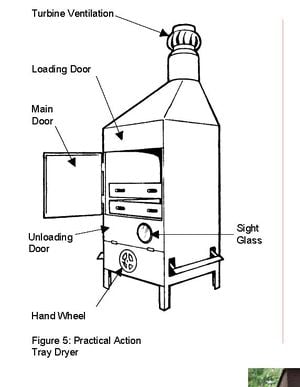
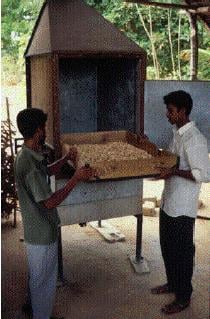
It is in the dried condition the kernels are most vulnerable, being both brittle and susceptible to insect infestation. Therefore, at this stage, they must be handled with care and moved to the next stage of peeling as quickly as possible.
Peeling
At this stage, the testa is loosely attached to the kernel, although a small amount of kernels may have already lost the testa during the previous operations. Manual peeling is done by gentle rubbing with the fingers. Those parts still attached to the kernel are removed by the use of a bamboo knife. One person can peel about 10-12kg of kernels per day.
Figure 6: The Practical Action Tray Dryer in Sri Lanka ©Practical Action/Zul
The mechanised processes of peeling differ widely. They include air-blasting, suction, a freezing operation and a system of rubber rollers. The operation has a low efficiency due to the difficulty of removing the testa and the amount of breakages can be as high as 30%. Currently research and development is taking place to improve the viability of the mechanisation of this operation.
Grading
The grading operation is important as it is the last opportunity for quality control on the kernels. With the exception of a few grading aids, all grading is done by hand. Power driven rotary sieves are one mechanical method, another being two outwardly rotating rubber rollers aligned at a diverging angle. For large operations looking towards export markets, it is necessary to grade the kernels to an international level.
Rehumidification
Before the kernels are packed it is necessary to ensure that their moisture content rises from 3% up to around 5%. This is to make the kernels less fragile, thus lessening the risk of breakage during transport. In humid climates, the kernels may absorb enough moisture during peeling and grading to make a further rehumidification process unnecessary.
Packing[edit | edit source]
The normal packaging for export of kernels is in air-tight tins of 25lbs in weight. The packing needs to be impermeable as cashew kernels are subject to rancidity and go stale very quickly. The tin will be familiar to most tropical countries as it is a replica of the four gallon kerosene or paraffin oil tin. If possible the tins are made locally as movement of empty tins overseas is expensive. Alternatively, it might be arranged to purchase components and finish the manufacturing locally. This may be done by arrangement with tin manufacturers. The output of a tin manufacturing line is usually too large for one consumer but some cashew nut processors have in fact installed their own tin making plant and supply other processors.
After filling and weighing, the cap should be soldered on in preparation for the 'vita pack' process. This consists of removing all air from the tin and substituting this with carbon dioxide (CO2). The advantages of packing cashew kernels in carbon dioxide are twofold. Firstly, carbon dioxide is an inert gas and will not support life. Any infestation that may have been present is therefore arrested. Secondly, carbon dioxide is soluble in cashew oil and goes into solution as soon as the seals are made. In a short space of time, it can be seen that a decrease in pressure takes place as the carbon dioxide goes into solution and the sides, top and bottom are drawn inwards. Thus the kernels are held tight in the tin, preventing movement and breakage during transport. Carbon dioxide, being a heavy gas causes the upward displacement of air and will remain in the tins after the filling process. Some large-scale machines will operate on six tins at a time, creating a vacuum in each and then filling with carbon dioxide.
Some processors do not have vacuum pumps and displace the air in the tin by feeding in carbon dioxide through a small hole in the bottom of a side of the tin. The carbon dioxide valve is turned off when all the air has been replaced. The holes in the tin are then sealed, with the hole at the bottom of the side of the tin being done first, and the one on the top last.
Infestation[edit | edit source]
Far too little attention is paid to the infestation hazards of cashew kernels. These hazards are more prevalent at some times of the year than others, however a good processor will be vigilant all the time. The main insect pests are:
- ants
- grain weevils
- meal moths
The most important defence against infestation of any type is cleanliness and is essential in the rooms used for drying, peeling, grading, conditioning, and packaging. Floors and walls must be sound and free from cracks. They should be kept white-washed regularly. Some processors have filled the corners and places where the wall meets the floor with a curved filling so that the room can be properly swept, all corners having been eliminated.
Speed of operations between drying and packaging must be stressed as this reduces the critical period when attacks may occur to a minimum. The equipment used must also be thoroughly cleaned on a regular basis as insects may breed in hidden crevices and gaps.
Suppliers[edit | edit source]
Roaster
Rajan Universal Exports (Manufacturers) PVT Ltd., Raj Buildings, 162 Linghi Chetty Street,
Post Bag No.250, Chennai - 600 001, India.
Tel: +91 44 2534 1771 / 25340731
Fax: +91 44 2534 2323
- Bruioir Roaster: Fitted with an electrical heater, it also has a space for a kerosene burner. The rotary drum with cross blades gives uniformity and a quick discharge of materials into the cooling tray. The automatic stirrer moves and discharges the roasted material to the final storage tank. The colour changes can be seen through a viewfinder. Requires between 0.5 and 1.5 h.p., depending on the model.
Sheller
THA DEPAG, Department of Agriculture, Agricultural
Engineering Division, Bangkhen, Bangkok - 10900,
Thailand. Tel: +66 2 5792153/5794497
- THA DEPAG: A small tool for bench use with a specially shaped blade set. The complete nut is placed on the lower blade and when the spring-loaded handle is depressed, the upper blade is pushed down into the shell. The handle can then be pushed sideways to exert a twisting motion on the shell and thus open it.
Cashew Nut Decorticator
Kunasin Machinery, 34 Soi Ladphrod, 126 Ladphrod Road,
Wangtonglong, Bangkaip, Bangkok – 10301, Thailand.
Dryers
Intermediate Technology Development Group
- Semi-continuous Tray Dryers
- Batch Tray Dryer
- Anagi Tray Dryer
Details are available from the UK office of Practical Action Details are available from Practical Action South Asia
References and further reading[edit | edit source]
- Cashew by J. G. Ohler, KIT, ISBN 90 6832 074 2, 1988
- Food Chain: The International Journal of Small-scale Food Processing: Number 28 May 2001 Special issue dedicated to cashew processing and marketing, Practical Action
- Food Chain: The International Journal of Small-scale Food Processing: Number 24 May
1999 Empowering Small-scale Cashew Processors in Sri Lanka, Practical Action
Practical Action
The Schumacher Centre
Bourton Hall, Bourton-on-Dunsmore
Rugby, Warwickshire, CV23 9QZ
United Kingdom
Tel: +44 (0)1926 634400
Fax: +44 (0)1926 634401
E-mail: infoserv@practicalaction.org.uk
Practical Action South Asia
5 Lionel Edirisinghe Mawatha
Kirulapone
Colombo 5
Sri Lanka
Tel: +94 11 2829412
Fax: +94 11 2856188
E-mail: general@practicalaction.slt.lk